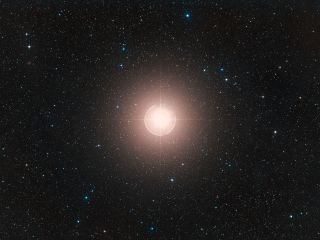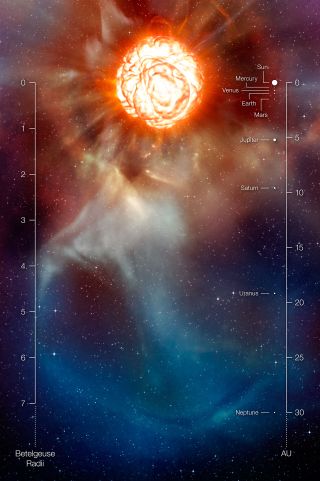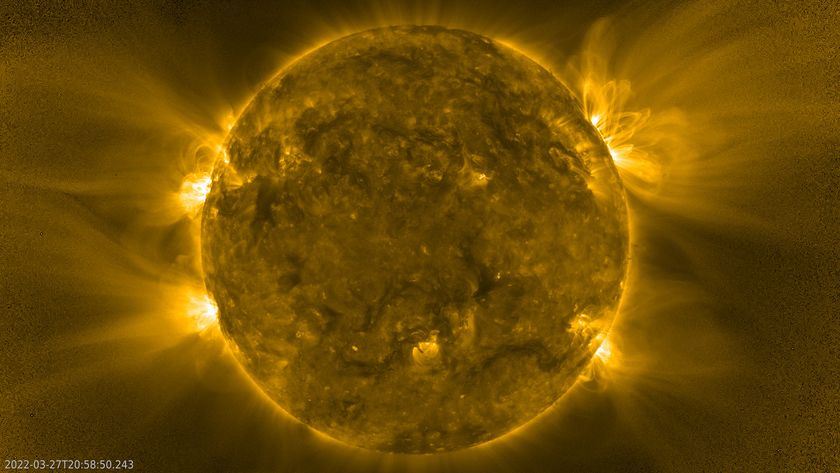Will Bright Star Betelgeuse Finally Explode? A Look at the Dimming Red Giant in Orion's Shoulder
It can't hurt to look up at the night sky just in case.
One of the brightest stars in the sky has been dimming. But, while it might be signaling that it's ready to explode, it's probably just fading because of strange, stellar physics.
Betelgeuse, a reddish star that's one of the brightest in the night sky, has been noticeably "fainting," or getting dimmer. The approximately 8.5 million-year-old star, which is part of the Orion constellation, has been one of the most recognizable stars in the sky because of its brightness and coloration. But this recent, dramatic fading has prompted scientists to suggest that the star might be entering a pre-supernova phase, dimming before it collapses and "dies" in a fiery supernova explosion.
If the star does become a supernova, Betelgeuse would likely be as bright as, or even brighter than the moon for weeks or even more.
At 642.5 light-years from Earth, it would be the closest supernova observed and recorded by humans (closer than the Crab Nebula, which is 6,523 light-years from Earth and is the result of a supernova reported to have taken place in A.D.1054). This also means that, if we see Betelgeuse explode tonight, the supernova really took place over 600 years ago, we're only seeing it now.
Video: Will the Giant Star Betelgeuse Explode?
Related: The Brightest Stars in the Sky: A Starry Countdown

"It'd be brilliant," the star would be so bright that it would make it difficult to see other stars near it," Edward Guinan, a professor of astronomy and astrophysics at Villanova University who reported the dimming in an Astronomer's Telegram, told Space.com. "It would be the brightest supernova ever observed in our galaxy."
But … will we really see Betelgeuse explode?
Get the Space.com Newsletter
Breaking space news, the latest updates on rocket launches, skywatching events and more!
A massive, dimming star
It's not surprising that the extremely massive star (which is likely about 20 times the mass of the sun) has been dimming, because it's a variable star — meaning its brightness naturally shifts, something that scientists have observed for decades. The star has been classified a red supergiant star because of its size. However, with this recent dimming, the star's brightness "kept going down beyond the limits that we [scientists] ever saw it … it went outside of its usual parameter or comfort zone," Guinan said.
"It's dimming a lot more than we've seen," Sarafina Nance, an astronomy graduate student who studies Betelgeuse and stellar explosions at UC Berkeley, told Space.com. But, "does that dimming foretell an explosion? We know massive stars like Betelgeuse will explode as [a] supernova. The question is, when?"
"There really haven't been close observations of them [supernovae] before they go off," Guinan said. He explained that, while some think that there wouldn't be any visible, major changes in the star until just hours before it blows up, others think that it would start to dim about a year before exploding. "There's no true consensus."
While it's possible that the star could explode anytime between now and 100,000 years from now, this dimming might not actually be a sign that it's about to blow, both Nance and Guinan said.

A false alarm?
While he acknowledges that it could explode soon and this dimming could be a sign that that explosion may happen relatively soon, "I believe it isn't going to blow up now," Guinan said. "I hope it does, but my bet is that it's not going to, it's gonna come back up [get brighter] again."
Nance admits that "we could absolutely be wrong," she said, referring to her theory that the dimming is not a sign that the star is about to explode. That said, "I do think that this is more indicative of really interesting physics that's going on with the star rather than an imminent explosion."
"If it does explode and we're wrong, awesome — I would love to be wrong, I would love to see that," Nance said.
While it would be pretty amazing to witness the ultrabright transformation of such an enormous and close star into a supernova, Guinan said, it seems more likely that this dimming does not indicate a pre-supernova phase and can be explained in another way.
According to Nance, while no one is exactly sure why this stellar fainting is happening, it could be caused by instabilities within Betelgeuse. She explained that different parts of stars can have different densities, and this density instability can cause energy to rise and fall within a star, moving energy from its inside to its outside. This, in turn, and can cause changes in brightness, cause the star to get bigger, to contract and much more.
Nance added that this extreme dip in brightness could also be attributed to magnetic activity on the star, but it is difficult to model that activity through simulations, so they do not yet know if that is a definite factor. She even added that it's possible that matter ejected from the star is creating "a sort of dust fog" that's currently obscuring and "dimming" the star.
The likely lack of a nearby explosion might make this star seem less interesting, but Nance thinks just the opposite. "I think that this is really interesting to watch and really interesting from a physics perspective of trying to better understand how massive stars experience periods of variability," she said.
You should still look up!
Now, while both Nance and Guinan think that it's most likely that Betelgeuse is just displaying a dimmer appearance because of some interesting stellar physics, they also agree that an explosion in our lifetime is still possible, and it's worth it to look up and look for the dimming star in the night sky.
While "I don't think it's going to explode anytime soon," Nance said, "I'll keep my eye on it, just in case."
"We don't know what's going to happen. There are absolutely limits to our models," she added. "I'm gonna look up at the night sky and check that it's still there every time I go outside."
Even if it is in a pre-explosion phase, it's exciting to watch the star now as it dims. It's "kind of neat to see astrophysics or astronomy and stellar evolution in action," Guinan said. These "changes are usually so slow that you can't observe them."
- Meet ALMA: Amazing Photos from Giant Radio Telescope
- How Can a Star Be Older Than the Universe?
- When Will the Sun Die?
Follow Chelsea Gohd on Twitter @chelsea_gohd. Follow us on Twitter @Spacedotcom and on Facebook.

Join our Space Forums to keep talking space on the latest missions, night sky and more! And if you have a news tip, correction or comment, let us know at: community@space.com.

Chelsea “Foxanne” Gohd joined Space.com in 2018 and is now a Senior Writer, writing about everything from climate change to planetary science and human spaceflight in both articles and on-camera in videos. With a degree in Public Health and biological sciences, Chelsea has written and worked for institutions including the American Museum of Natural History, Scientific American, Discover Magazine Blog, Astronomy Magazine and Live Science. When not writing, editing or filming something space-y, Chelsea "Foxanne" Gohd is writing music and performing as Foxanne, even launching a song to space in 2021 with Inspiration4. You can follow her on Twitter @chelsea_gohd and @foxannemusic.
-
rod ReplyAdmin said:Betelgeuse is dimming, which could mean that it's about to explode. But scientists aren't convinced it's ready to blow.
Will Betelgeuse Finally Explode? A Look at the Dimming Red Star in Orion's Shoulder : Read more
Luminosity variations like Betelgeuse show up on the H-R diagram position and plot for the star. Apparently, Betelgeuse is undergoing some interesting stellar evolution changes. -
HarmsworthAG It isn't really relevant, but I chose to use the explosion of Betelgeuse as the main plotline in one of my hard science fiction books called Mindslip. Just shows that real life can be stranger than fiction. Hope the results in my story don't come true! LOL,Reply -
rod ReplyHarmsworthAG said:It isn't really relevant, but I chose to use the explosion of Betelgeuse as the main plotline in one of my hard science fiction books called Mindslip. Just shows that real life can be stranger than fiction. Hope the results in my story don't come true! LOL,
FYI. The study of red supergiant stars exploding as supernovae, was shown to have real problems in 1987 when SN 1987A became visible to instruments on Earth. The progenitor star was not a red supergiant but blue giant star. Stellar evolution modeling has some kinks that are being worked on today. I offer no prophecy here about the future of Betelgeuse :) -
Vaz Much as it would be brilliant to see (excuse the pun), I don't care all that much about it. My interests when it comes to space lie more on the planet Venus and Barnards Star.Reply -
criggsb33 I'm wondering if there could be any habitable worlds around Betelgeuse, and if so, what would be their fate should it explode?Reply -
Vaz It wouldn't be good. depending on how close the planets orbited, to the star in it's red giant phase, theyd either be vaporised or flung off into deep space to become what is called a rogue planet. When it comes to habitable worlds, sorry but they don't have a hope in hell. Doesn't matter how far away the planet is from a red giant, when that goes boom, the explosion will tear it apart. But any life on such a planet wouldn't need worry about that, as the intense radiation given off from Betelguese will have baked the planet surface and killed every thing long before the star explodes anyway.Reply -
oaflet Reply
That would be pretty hard on the reinsurance marketplace.criggsb33 said:I'm wondering if there could be any habitable worlds around Betelgeuse, and if so, what would be their fate should it explode?
I hope that none of my financial instruments have any exposure. -
Hawkstein ReplyHarmsworthAG said:Thanks for that info, Rod. If you'd like a free copy of Mindslip, send your email address to tony @ harmsworth.net, cheers.
Out of curiosity, have any other published books? -
sgtnos Reply
Here is the real question. Is it a recurrent nova and what are the characteristics? As far as I know we keep finding more, so I have little faith in any of the mainstream star life cycles. Electric Universe seems to be most correct or at least nowhere near as incorrect as Relativity.Admin said:Betelgeuse is dimming, which could mean that it's about to explode. But scientists aren't convinced it's ready to blow.
Will Betelgeuse Finally Explode? A Look at the Dimming Red Star in Orion's Shoulder : Read more


